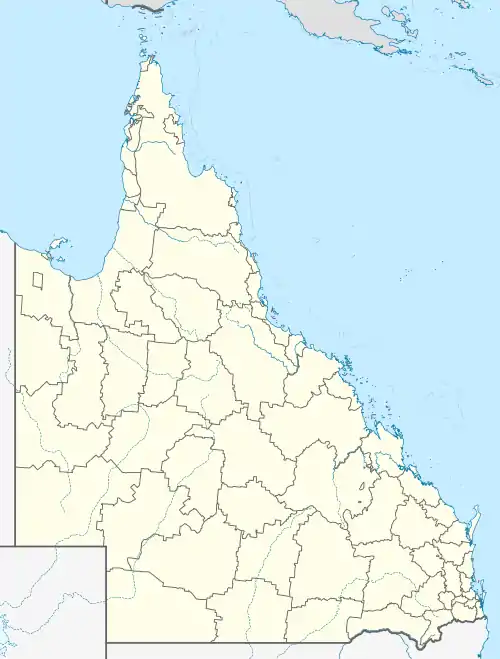Buderim (suburb)
Buderim is the central suburb of the town of Buderim in the Sunshine Coast Region, Queensland, Australia.[2][3] In the 2016 census the suburb of Buderim had a population of 29,355 people.[1]
| Buderim Sunshine Coast, Queensland | |||||||||||||||
|---|---|---|---|---|---|---|---|---|---|---|---|---|---|---|---|
 Buderim | |||||||||||||||
| Coordinates | 26.6847°S 153.0532°E | ||||||||||||||
| Population | 29,355 (2016 census suburb)[1] | ||||||||||||||
| • Density | 962.5/km2 (2,493/sq mi) | ||||||||||||||
| Postcode(s) | 4556 | ||||||||||||||
| Area | 30.5 km2 (11.8 sq mi) | ||||||||||||||
| Time zone | AEST (UTC+10:00) | ||||||||||||||
| Location |
| ||||||||||||||
| LGA(s) | Sunshine Coast Region | ||||||||||||||
| County | Canning | ||||||||||||||
| State electorate(s) | Buderim | ||||||||||||||
| Federal Division(s) | Fairfax | ||||||||||||||
| |||||||||||||||
It is the central suburb of the town of Buderim and comprises 63% of Buderim's urban population.
History
The suburb takes its name from the Kabi language word badderam meaning red soil and red honeysuckle (a species of Banksia) Kabi language, Undanbi group. Refer J.G. Steele. Aboriginal pathways. Brisbane, 1983, p.179.[3]
Buderim Mountain Provisional School on 5 July 1875. Circa 1887 it became Buderim Mountain State School.[4]
Buderim Road State School opened on 7 February 1916 but was quickly renamed Mons State School. It closed in 1974.[4]
Immanuel Lutheran College opened on 30 January 1979.[4]
Matthew Flinders Anglican College opened on 1 November 1989.[4]
In the 2016 census the suburb of Buderim had a population of 29,355 people.[1]
Population
According to the 2016 census of Population, there were 29,355 people in Buderim.
- Aboriginal and Torres Strait Islander people made up 1.1% of the population.
- 72.3% of people were born in Australia. The next most common countries of birth were England 7.3%, New Zealand 4.7%, South Africa 1.6%, Scotland 0.7% and Germany 0.7%.
- 90.2% of people spoke only English at home. Other languages spoken at home included German 0.6% and Afrikaans 0.5%.
- The most common responses for religion were No Religion 31.1%, Catholic 19.4% and Anglican 18.2%. [1]
According to the 2016 census, Buderim had a population of 29,355, largely made of people of European descent. Buderim has the largest communities of Australians with English (13,685; 32.9%), Irish (4,059; 9.8%), Scottish (3,885; 9.3%), German (1,955; 4.7%), Dutch (586; 2.0%), and Welsh ancestry (313; 1.1%) out of any suburb in Queensland.[5][6]
Heritage listings
Buderim has a number of heritage-listed sites, including:
- 5 Ballinger Crescent: Pioneer Cottage[7]
- 12 Dixon Road: Canambie Homestead[8]
- 10 Orme Road: Buderim House[9]
- Telco Road: Palmwoods-Buderim Tramway[10]
References
- Australian Bureau of Statistics (27 June 2017). "Buderim (SSC)". 2016 Census QuickStats. Retrieved 20 October 2018.

 Material was copied from this source, which is available under a Creative Commons Attribution 4.0 International License Archived 16 October 2017 at the Wayback Machine.
Material was copied from this source, which is available under a Creative Commons Attribution 4.0 International License Archived 16 October 2017 at the Wayback Machine. - "Buderim – town in Sunshine Coast Region (entry 4915)". Queensland Place Names. Queensland Government. Retrieved 29 December 2020.
- "Buderim – suburb in Sunshine Coast Region (entry 48546)". Queensland Place Names. Queensland Government. Retrieved 29 December 2020.
- Queensland Family History Society (2010), Queensland schools past and present (Version 1.01 ed.), Queensland Family History Society, ISBN 978-1-921171-26-0
- "2016Census_G_QLD_SSC - Census DataPacks - General Community Profile". Australian Bureau of Statistics – Census 2016. Archived from the original on 29 July 2017. Retrieved 18 July 2017.
- Australian Bureau of Statistics (27 June 2017). "Buderim (State Suburb)". 2016 Census QuickStats. Retrieved 18 July 2017.

- "Pioneer Cottage Buderim (entry 600688)". Queensland Heritage Register. Queensland Heritage Council. Retrieved 14 July 2013.
- "Canambie Homestead (entry 602166)". Queensland Heritage Register. Queensland Heritage Council. Retrieved 14 July 2013.
- "Buderim House (entry 601176)". Queensland Heritage Register. Queensland Heritage Council. Retrieved 14 July 2013.
- "Palmwoods to Buderim Tramway Track Foundation and Formwork Remnants (entry 601711)". Queensland Heritage Register. Queensland Heritage Council. Retrieved 14 July 2013.
External links
| Wikimedia Commons has media related to Buderim, Queensland. |
- "Buderim". Queensland Places. Centre for the Government of Queensland, University of Queensland.